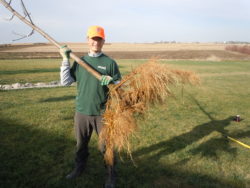What to Replace Your Ash Tree With in Sioux Falls?
The decision to treat your ash tree or to remove and replace it is a decision with no right or wrong answer. Unfortunately, emerald ash borer is forcing most of our hands in that we must make a decision. If you have decided that you are not going to save your ash tree(s), you’ll need to come up with a plan to remove them and consider what to replace the ash trees with.

A bare root tree is the best option in my opinion to replace a tree.
What species you replace it with?
This is the perfect time to change the way we have been planting trees and species of trees for generations and ultimately establish what the urban forest of Sioux Falls will be for generations to come. The best answer I can tell you is to replace with something that you don’t already have and something your neighbors don’t have. Diversity in our urban forest will make it more resilient to future pest and disease issues. We are in an ever increasing global market and more than likely other species and family specific tree diseases and pests will come through down the road and do the same thing that Dutch Elm Disease did and now emerald ash borer will do.
If you need to plant five trees. Buy and plant five different species of trees. We need to get over this idea of having rows of all the same species of tree. It is not good to be doing the same things over and over, but expecting different results.
Maples are already over planted in replacement of ash, so planting them in replacement is a very poor idea. Maple is the most abundant family of trees in the world. There are more species of maple in the world than all other tree species combined. There is already Asian longhorn beetle in the eastern US and guess what, they kill maple trees. Diversity in species, genera, and families of trees will be your best bet to not being stuck with this decision again.
So what, then? Here is a partial list of trees that I know will generally grow well around the Sioux Falls area (in no particular order):
-
Bur oak
-
Hackberry
-
Honeylocust
-
Black locust
-
Elm (dutch elm disease resistant varieties)
-
Kentucky Coffeetree
-
Buckeye (Horse-chestnut)
-
American Linden
-
Northern Catalpa
-
Ginko
-
Amur Corktree
-
Shagbark Hickory
-
Black Walnut
-
Eastern Larch
-
Eastern Cottonwood
Here are some links to other related articles you may find interesting:

